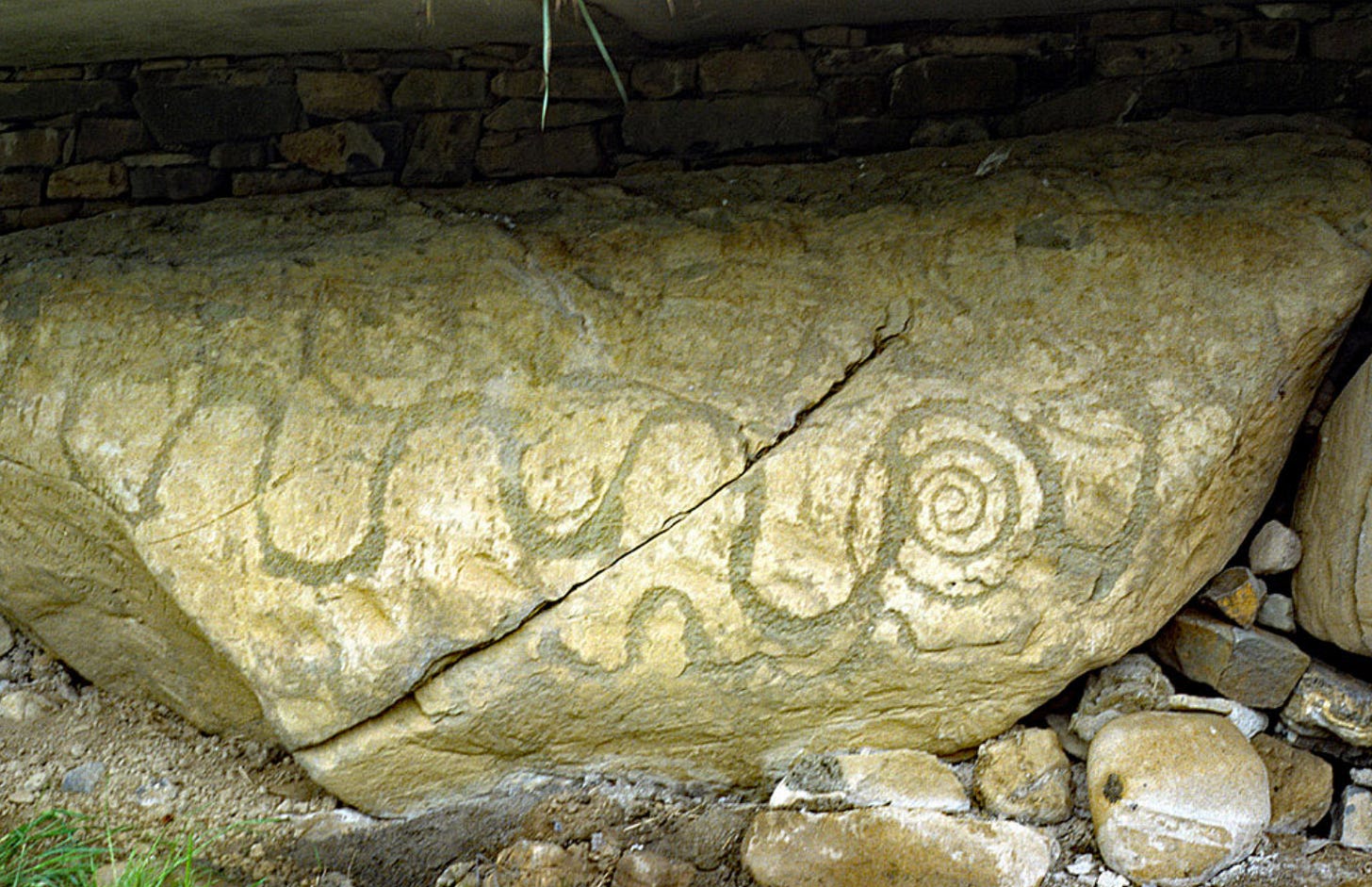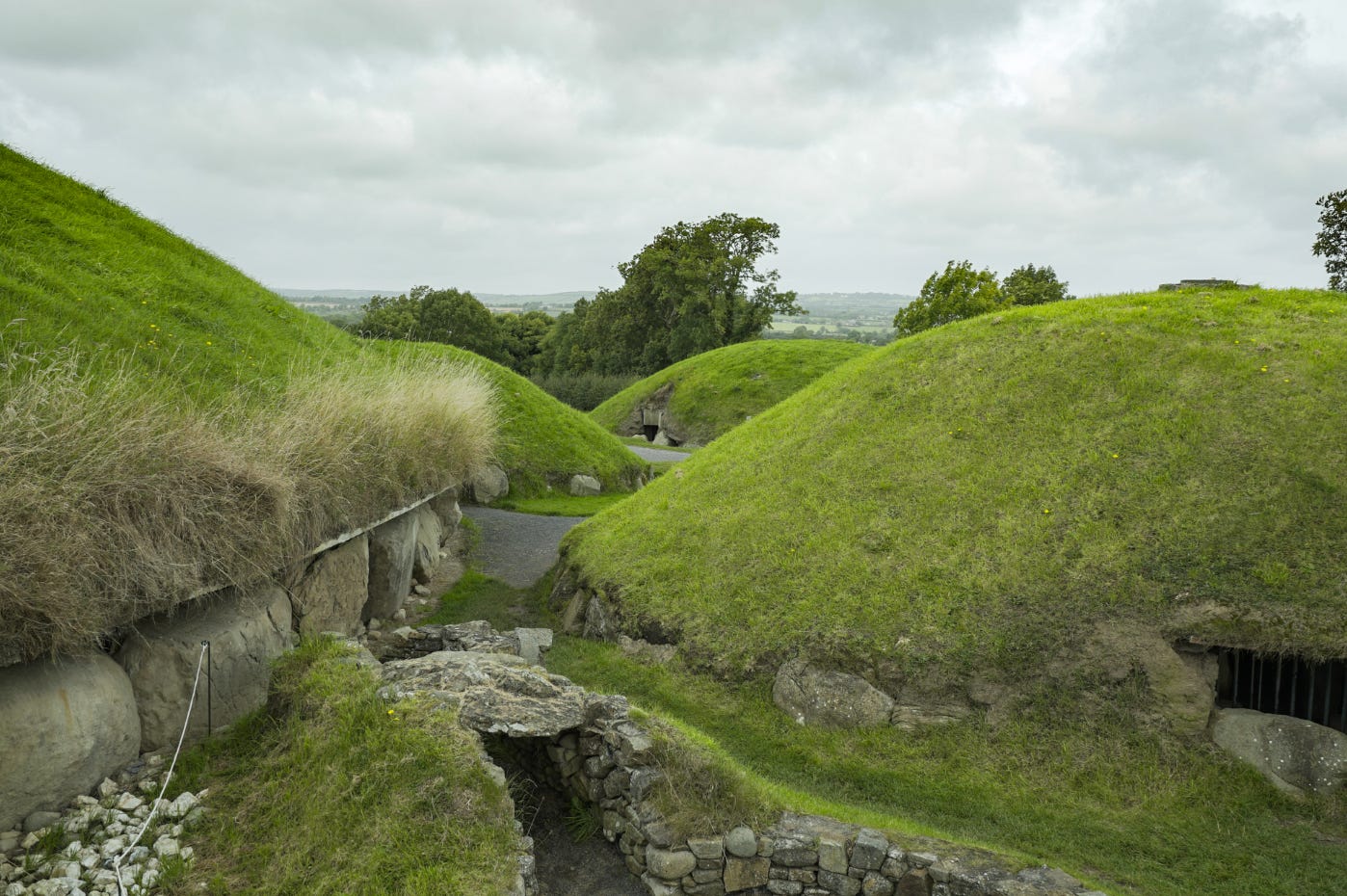Fresh Batch #54: The Kerbstones at Knowth
Are They Connected to the Egyptian Priesthood?
According to Wiki, Knowth (/ˈnaʊθ/; Irish: Cnóbha) is a Neolithic passage grave and an ancient monument of the World Heritage Site of Brú na Bóinne located 8.4 km west of Drogheda in Ireland's valley of the River Boyne. It is the largest passage grave of the Brú na Bóinne complex. It consists of a large mound (known as Site 1) and 17 smaller satellite tombs. The mound is about 12 metres (40 ft) high and 67 metres (220 ft) in diameter,[1] covering roughly a hectare. It contains two passages placed along an east-west line and is encircled by 127 kerbstones, of which three are missing, and four badly damaged.
Cnóbha is essentially Chnoubis, an Egyptian equivalent to Abraxas. This is significant because Abraxas is called ΙΑΩ or Ιαω (Iota Alpha Omega), which Iao. Remove the first letter (the Greek chi, looks like X) and it becomes noubis, which is the same as Anubis. If you recall the Greek beta (B) sounding like V, then you have the same root in all of these words, ovis, which is a sheep. Add the I or J and it becomes Iovis/Jovis (Jove; Yo-Vuh: Tetragrammaton).

Even if I didn’t have this system available to me in English, I could use the inscriptions found on talismans of Abraxas and Anubis, namely a word that no one seems to know, which means it has hidden meaning (this is from the Gnostics after all): Σεμεσειλαμ (Semeseilam; it’s written in reverse on the black and white rendering, which is curious since Iao is not written in reverse, so if it were a seal, at least one of the names would be mirrored): sometimes it appears Σεμεσε (keep in mind this variant of Greek used C as an S).


It’s claimed Σεμεσειλαμ means “light-maker”, which is the eternal sun, as Blavatsky called Abraxas. Semes or Shemesh, is the sun (the s/sh are the same letter in older alphabets). David Moore Robinson noted that there are variants of the name Semeseilam, including Semesilamps, Semesilampsa, Semesilamph, and Semesilampe. Ilam may be a form of Ilion, another word for Troy, which is phonetically Helios. If it’s a modern construct, it could be The Am, as in I am. You’ll see what this matters shortly pertaining to Am being an Ammonian radical meaning the heat. Il is another form of El, which is power/God, used as the word the in both Italian and Spanish respectively. Something else I can add is that Abraxas in reverse is Saxarba (Sax-Arba), which would be the Wise-Four, literally, but it is the root for words like Sage in several languages. Four is Tetra, seen in Tetragrammaton, so this Sage of Four could be the sun in the four seasons, or cardinal cross, or the chariot of the four elements. Arba or Araba is an Asian wagon, carriage, or cart that is drawn by oxen or horses, and Jesus was a carpenter, from the Latin Carpentarius, which means cartwright, or a car-maker, a carriage driver or coachman. As I noted in A Godsacre for Winds of the Soul (but not in the context of Abraxas or Chnouphis), this is the real meaning of carpenter, or car-pater, the father of the car. He is the Maker: God. All of this symbolism is laid up in the chariot of Helios, Apollo, and others. In reverse, Ilam could be Mali, which given the M and W interchange between Latin and Sanskrit and the B and W interchange (Will, Bill, War, Barracks, etc.), would make it Bali/Baali. (Thou shalt no longer call me Baali; Hosea 2:16; Ishi is another play on the word for savior (iso) and Christ (Isa; Arabic). But as it also looks like Mali a clever way of disguising Mani (Manichaeans).








There’s another symbol of the sun on a broken gem of Abraxas that will connect him to Odin and Suparshvanatha. Can you see it? Hint: it’s a form of the cross.



These are all from different sources, so I will link them.
Ἀβρασάξ; Ἰάω; Ἰάω, variants; σεμεσειλαμ and variants; Γαβριήλ and variants (Note that one variant is Gabriel.)
Magical spindle-shaped object: Lion-headed deity (A) σεμεσειλαμ (B) Anubis (C) vox (D)
Did you think it ended there? Recall the b and f/ph interchange. Chnubis is also the name Chuphis, Kneph, Nef, Nouf, Cneph, Cnouphis, Chnoubis, Ammon-Chnoubis, which are all names for Khnum. According to Wiki, Khnum, also romanised Khnemu (/kəˈnuːm/; Ancient Egyptian: 𓎸𓅱𓀭 ẖnmw, Koinē Greek: Χνοῦβις/Chnoubis), was one of the earliest-known Egyptian deities, originally the god of the source of the Nile. (Thus a god of fertility.)
Nice head you’ve got there… It’d be a shame if someone… discovered it. Is that a ram? Would it be Rama/Roma, the most high as in Abram (Father the Most High)? How about a Ram or Lamb of God, Agnus Dei?



Who else was a God of the Nile? Serapis, Augustus, Neilos, Moses, Jesus, Bacchus (bach means stream/river), and many more. Again from A Godsacre for Winds of the Soul, “Recall that Moses is a name for the Initiates, the physical and metaphysical symbolism of the Nile, and the living waters of the Christos, the Christ, and the Bishops thereof: Serapis. Augustine wrote, ‘We come down to Moses, the ocean of theology out of which all rivers and all seas flow.’
“In a letter to Servianus, Emperor Hadrian wrote, ‘Those who worship Serapis are likewise Christians; even those who style themselves the Bishops of Christ are devoted to Serapis.’”
I cited Martianus Capella, “Latium calls thee Sol, because thou alone art in honour, After The Father, the center of light; and they affirm that thy sacred head bears a golden brightness in twelve rays, because thou formest that number of months and that number of hours. They say that thou guidest four winged steeds, because thou alone rulest the chariot of the elements. For, dispelling the darkness, thou revealest the shining heavens. Hence they esteem Phœbus, the discoverer of the secrets of the future; or, because thou preventest nocturnal crimes. Egypt worships thee as Isæan Serapis (Isæum Te Serapis Nilus)—and Memphis as Osiris (Memphis venerator Osirim). Thou art also the beautiful Atys, and the fostering son of the bent plough. Thou art the Ammon or arid Libya, and the Adonis of Byblos (Biblius Adon).”
Adonis is the god of the Old Testament, hence the word Aduni (אדוני), which means my Lord. Who is your Lord and Savior?

Augustus meant sanctity and deification upon the earth, and according to Basnage, the Nile was called King Augustus by the Egyptians. Which brings us to Neilos (Latinized Nilus) and Tiberinus, both gods of their respective rivers.


And then we have Serapis, Bacchus, Jupiter/Zeus, Moses, Jesus, all of whom are indistinguishable through symbolism and language. What is the oldest statue of Moses? Keep in mind, when searching for that answer, that Greeks and Romans were carving lifelike statues out of marble prior to the common era.









Who admitted to being Iao (Ιαω; Iota Alpha Omega), an old name for the sun? Jesus, in the Apocalypse (22:13) or great unveiling at the final stage of initiation in the Eleusinian mysteries, admitted he is Iao, the sun, “Behold, I am coming soon, and My reward is with Me, to give to each one according to what he has done. I am the Alpha and the Omega, the First and the Last, the Beginning and the End.”
Again from A Godsacre for Winds of the Soul, “Clement of Alexandria (Stromatis) wrote that those who entered the temple of Serapis were required to wear the name I-ha-ho, or I-ha-hou, meaning the God Eternal: Yahou (another way of pronouncing Jove/Ieue/Jewe/Yhwh/Tetragrammaton). Abbé Bazin alleged this to come from an inscription on the temple of Isis at Sais, which read I am that I am.”
I know this may be difficult for you, as even you become unable to unsee the ancient universal system of priestcraft, but you are not a victim of the Illuminati (the upper echelon of the priests who knew how to read the gospels; admittedly Oriental Gnostics). They invent these systems. You are under no obligation to believe that they are history, though many of them will lie and claim their allegories are history. The Gnosis signified the perfection and full attainment of wisdom (Sax/Sac/Sag). Gnosticism comprehends the doctrine of the Magi, the wise men of the east, the Brahmins, the philosophy of the Persians, Chaldeans, and Arabians, and the wisdom of the Indians and Egyptians. The father of ecclesiastical history, Eusebius, admitted it, “Those ancient Therapeutae were Christians, and their writings are our gospels and epistles.”
Therapeuts were Jewish Buddhists. The west has been infested with this cult, and regardless of what anyone thinks about it, this system is partially responsible for both the good and bad that came from their civilization. However, they never could have scared you and your ancestors into doing their bidding if they didn’t lie to you about the nature of reality and put the fear of God into you. And you never would’ve questioned their authority if you accepted the historicity of their divine right to rule you based on their descent from religious figures, the ultimate claim of authority being bestowed upon them by God.
Well, I’ve just tossed you the key that unlocks your shackles. What will you do with it?
Thanks to the ancient maritime empire known as the Phoenicians, the priests were able to set their ancient system up on the islands of Britain, likely thousands of years before the rest of Europe even knew Britain existed. Now that you know Knowth (Irish: Cnóbha) is likely connected to knowing the Doctrine of Wisdom, nauth (naut being the root of nautical), and the Egyptian priests, let us continue.
All 127 of the Knowth stones are documented here.
The ability to date artifacts (and almost anything in the ancient world) is not accurate, thus not reliable. What is one dating? The stone? Just because the stone could be dated does not mean the markings on it correspond to that antiquity. According to Saints and Stones, “Knowth is a Neolithic passage grave built over 5,000 years ago, probably after the construction of Newgrange and before the construction of Dowth. The largest mound (known as Site 1) is similar in size to Newgrange, surrounded by 17 smaller satellite mounds, is encircled by 127 kerbstones, and has two long passages with entrances on opposite sides.”
The Newgrange tumulus and the Knowth tumuli fashioned in the style of the Etruscan tumuli, however the masonry is not as good. Is this due to lack of resources, the antiquity, or is this a coincidence? Keep in mind Britain was peopled by Phoenicians and Etruscans are descended from Phoenicians, or whoever made up the maritime empire if Phoenician is just a placeholder term. Here is what the Etruscan tumuli of Banditaccia look like. This is Italy. Newgrange and Knowth are in Ireland.
I don’t know of anyone else alive who is using language like I am to corroborate the history of the ancient universal maritime empire. To learn more about Etrusco-Phoenicians and their peopling of the British Isles, read The Holy Sailors. (Click the image.)
To see why language matters, especially at Knowth, keep reading.
Become a member to access the rest of this article.
Keep reading with a 7-day free trial
Subscribe to Ancient History, Mythology, & Epic Fantasy to keep reading this post and get 7 days of free access to the full post archives.









